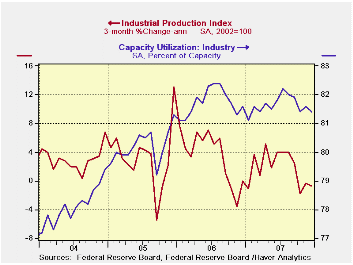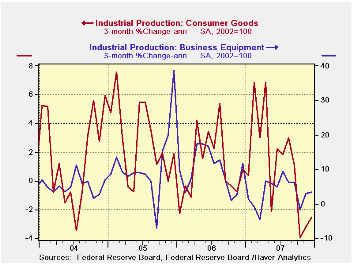 Global| Jan 16 2008
Global| Jan 16 2008U.S. Industrial Production Unchanged in Dec. A Recession Begun?
by:Tom Moeller
|in:Economy in Brief
Summary
Industrial production was unchanged last month, a bit better than the expected slight decline. That followed an unrevised 0.3% November rise. For all of last year, the 1.6% increase in output was the weakest since 2003. The latest [...]

Industrial production was unchanged last month, a bit better than the expected slight decline. That followed an unrevised 0.3% November rise. For all of last year, the 1.6% increase in output was the weakest since 2003.
The latest output level is, however, 0.8% below its July peak and a move below peak historically has been associated with an economic recession. Has one begun? Other coincident economic indicators suggest not. Employment is up. Business sales are up. And income, though weak, is up.
Factory output also was unchanged after an unrevised 0.3% November increase. Three month growth in output fell to -1.4% (AR) and the latest level was 0.8% below its July peak.
Production in the motor vehicle & parts industries fell 0.4% and output was 5.2% below its July peak. The decline in output of furniture & related products was strong at -1.3% (-2.3% y/y) and it was 2.8% below peak. Output of construction supplies fell for the sixth consecutive month. The 0.9% (-2.2% y/y) drop pulled output 2.6% below its June peak.
Elsewhere in the consumer goods sector output was firmer. Production of computers & electronics slipped 0.2% but was up 13.1% y/y. Output of apparel jumped 1.7% but remained down 1.5% y/y)
Output of business equipment rose a solid 0.9% (2.4% y/y). Output of information & processing equipment rose 0.5% (8.2% y/y) after a 2.1% November surge. Output of industrial equipment rose 0.4% (-0.8% y/y).
In the materials category output fell 0.3% but it was up 2.3% for the year. Production of durable consumer parts slipped 0.3% (+2.3 y/y). Production of durable equipment parts fell 0.4% (+3.7% y/y) but consumer durable parts output (-2.7% y/y) fell for the fourth month in five.
Capacity utilization fell to 81.4% from a revised 81.4% and that was below the 2007 average of 81.6% which was down a bit from 81.7% in 2006. Utilization in the factory sector slipped more decidedly to 79.7% from its 207 average of 80.1% and from its July peak of 81.0%. Capacity grew 1.8% last year.
| INDUSTRIAL PRODUCTION (SA) | December | November | Y/Y | 2007 | 2006 | 2005 |
|---|---|---|---|---|---|---|
| Total | 0.0% | 0.3% | 1.6% | 1.9% | 4.0% | 3.2% |
| Manufacturing | 0.0% | 0.3% | 1.1% | 1.9% | 4.7% | 3.9% |
Tom Moeller
AuthorMore in Author Profile »Prior to joining Haver Analytics in 2000, Mr. Moeller worked as the Economist at Chancellor Capital Management from 1985 to 1999. There, he developed comprehensive economic forecasts and interpreted economic data for equity and fixed income portfolio managers. Also at Chancellor, Mr. Moeller worked as an equity analyst and was responsible for researching and rating companies in the economically sensitive automobile and housing industries for investment in Chancellor’s equity portfolio. Prior to joining Chancellor, Mr. Moeller was an Economist at Citibank from 1979 to 1984. He also analyzed pricing behavior in the metals industry for the Council on Wage and Price Stability in Washington, D.C. In 1999, Mr. Moeller received the award for most accurate forecast from the Forecasters' Club of New York. From 1990 to 1992 he was President of the New York Association for Business Economists. Mr. Moeller earned an M.B.A. in Finance from Fordham University, where he graduated in 1987. He holds a Bachelor of Arts in Economics from George Washington University.






